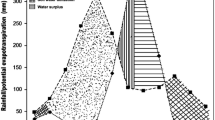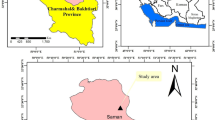Abstract
A long-term field study was initiated during 1995 at Central Soil Salinity Research Institute, Regional Research Station, Lucknow (26°47′58″ N and 80°46′24″ E) to analyze the effect of agroforestry systems on amelioration of alkali soils. Three agroforestry systems (pastoral, silvipastoral and silvicultural) were compared with the control where no agroforestry system was introduced. Tree-based silvicultural and silvipastoral systems were characterized by tree species Prosopis juliflora and Acacia nilotica along with grass species Leptochloa fusca, Panicum maximum, Trifolium alexandrium and Chloris gayana. Growth of ten-year-old Prosopis juliflora and Acacia nilotica planted in combination with grasses was significantly higher over the silviculture system with the same species. Tree biomass yields of P. juliflora (77.20 t·ha−1) and A. nilotica (63.20 t·ha−1) planted under silvipastoral system were significantly higher than the sole plantation of (64.50 t·ha−1 and 52.75 t·ha−1). Fodder yield under the pastoral system was significantly higher than the silvipastoral system during initial years but it was at par with that of silvipastoral systems after eight years of plantation. The microbial biomass carbon in the soils of silvipastoral systems was significantly higher than in soils under sole plantation of trees and control systems. The Prosopis-based silvipastoral system proved more effective in reducing soil pH, displacing Na+ from the exchange complex, increasing organic carbon and available N, P and K. Improvement in soil physical properties such as bulk density, porosity, soil moisture and infiltration rate was higher in the Prosopis-based silvipastoral system than in the silviculture system or control. On the basis of biomass production and improvement in soil health due to tree + grass systems, silvipastoral agroforestry system could be adopted for sustainable reclamation of highly alkali soils.
Similar content being viewed by others
References
Abrol IP, Prasad R. 1985. Karnal grass (Leptochloa fusca) for reclaiming alkali soil. In: Better farming in salt affected soils. Karnal, Haryana: No. 5: Central Soil Salinity Research Institute.
Bogdan AV. 1977. Tropical Pasture and Fodder Plants. New York: Longman Inc., pp. 77–86.
Bowen GD, Rovira AD. 1991. The rhizosphere, the hidden half of the hidden half. In: Waisel Y, Eshel A, Kafkafi U (eds), The Plant Roots: The hidden half, New York: Marcel Dekker, pp. 641–669.
Brady NC. 1990. The nature and Properties of Soils. New York: Macmillan Publishers.
Brechtel HM. 1976. Application of an inexpensive double ring infiltration: hydrological techniques for upstream conservation. Conservation Guide 2. Rome: FAO.
Chaturvedi AN, Behl HM. 1996. Biomass production trials on sodic site. Indian Forester, 122: 439–455.
Draper NR, Smith H. 1998. Applied Regression Analysis. New York: John Wiley and Sons.
Garg VK, Jain RK. 1992. Influence of fuel wood trees on sodic soils. Canadian Journal of Forest Research, 22: 729–735.
Garg VK, Jain RK. 1996. Effect of fuel wood plantation on some properties of sodic wastelands. Journal of Ttropical Forest Science, 9: 194–205.
Garg VK. 1998. Interaction of tree crops with a sodic soil environment: potential for rehabilitation of degraded environments. Land Degradation and Development, 9: 81–93.
Garg VK. 1999. Leguminous trees for the rehabilitation of sodic wastelands in Northern India. Restoration Ecology, 7: 281–287.
Gill HS, Abrol IP, Samara JS. 1987. Nutrient recycling through litter production in young plantations of A. nilotica and E. tereticornis in a highly alkali soil. Forest Ecology and Management, 22(1–2): 57–69.
Gill HS, Abrol IP. 1991. Salt affected soils, their afforestation and its ameliorating influence. International Tree Crops Journal, 6: 239–260.
Hellden U. 1992. Desertification time for an assessment. Ambio, 20: 372–383.
Jain RK, Garg VK. 1996. Effect of a decade old tree stands on some properties of soils while revegetating sodic wastelands. The Indian Forester, 122: 467–475.
Jain RK, Singh B. 1998. Biomass production and soil amelioration in a high density Terminalia arjuna plantation on sodic soils. Biomass and Bioenergy, 15: 187–192.
Kaur B, Gupta SR, Singh G. 2000. Soil carbon, microbial activity and nitrogen availability in agroforestry systems on moderately alkali soils in northern India. Applied Soil Ecology, 15: 283–294.
Kaur B, Gupta SR, Singh G. 2001. Bioamelioration of sodic soils by silvipastoral systems in north-western India. Agroforestry Systems, 54: 13–20.
Khanduja SD, Chandra V, Srivastava GS, Jain RK, Mishra PN, Garg VK. 1986. Utilization of alkali soils in the plains of northern India-a case study. In: Prinsley RT, Swift MJ (eds), Amelioration of Soil by Trees. London: Commonwealth Science Council, pp. 54–61.
Kumar A, Abrol IP. 1983a. Effect of gypsum on five tropical grasses grown in normal and extremely sodic soil. Experimental Agriculture, 19: 169–177.
Kumar A, Abrol IP. 1986. Grasses in Alkali soils. Bulletin No. 11, 95. Karnal: Central Soil Salinity Research Institute, ICAR.
Kumar A, Singh NT, Batra L. 1990–1991. Tree canopy inter-crop relationships in an agro forestry system. Report 1990–91. Karnal, Haryana: Central Soil Salinity Research Institute.
Kumar A. 1988a. Performance of forage grasses in saline soils. Indian Journal of Agronomy, 33: 26–30.
Kumar A. 1988b. Long term forage yields of five tropical grasses on an extremely sodic soil and resultant soil amelioration. Experimental Agriculture, 24: 89–96.
Kumar A. 1996. Use of Leptochloa fusca for the improvement of salt affected soils. Experimental Agriculture, 32: 243–149.
Lal B. 1998. Comparative performance of forage grasses with amendments and row spacing on saline sodic soils. In: 1st Agronomy Congress: Agronomy, Environment and food security for 21st Century. November, 23–27, 1998, New Delhi.
Lazarides M. 1970. The grasses of central Australia. Canberra: Australian national University Press.
Luken JO, Fonda RW. 1983. Nitrogen accumulation in a chronosequence of red alder communities along the Hon River., Olympic National Park, Washington. Canadian Journal of Forest Research, 13(6): 1228–1237.
Malik KA, Aslam Z, Naqvi M. 1986. Kallar grass-plant for saline lands. Faislabad, Pakistan: Nuclear Institute of Agriculture and Biology (NAIB).
Mannetje T, Kersten SMM. 1992. Chloris gayana Kunth. In: ’t Mannetje L, Jones RM (Eds), Plant Resources of South-East Asia No 4: Forages. Wageningen, Netherlands: Pudoc-DLO, pp. 90–92.
Mishra A, Sharma SD, Khan GH. 2002. Rehabilitation of degraded sodic lands during a decade of Dalbergia sissoo plantation in Sultanpur district of Uttar Pradesh, India. Land Degradation and Development, 13: 375–386.
Mongia AD, Dey P, Singh G. 1998. Ameliorating effect of forest trees on a highly sodic soil in Haryana. Journal of Indian Society of Soil Science, 46: 664–668.
National remote Sensing Application and Associates (NRSA and Associates). 1996. Mapping of salt affected soils of India, 1: 250,000 map sheets, Legend. Hyderabad, INDIA: NRSA.
Oster JD, Shainberg I, Abrol IP. 1996. Reclamation of salt affected soils. In: Agassi M (ed), Soil Erosion, Conservation and Rehabilitation. New York: Marcel Dekker, pp. 315–352.
Oster JD, Shainberg I, Abrol IP. 1999. Reclamation of salt affected soils. In: Skaggs RW, van Schilfgaarde J (eds), Agricultural Drainage. Madison, Wisconsin: ASA-CSSASSSA, pp. 659–691
Qadir M, Qureshi RH, Ahmad N. 1996. Reclamation of a saline sodic soil by gypsum and Leptochloa fusca. Geoderma, 74: 207–217.
Qadir M, Qureshi RH, Ahmad N. 1997. Nutrient availability in a calcarious saline sodic soil during vegetative biorememediation. Arid Soil Research and Rehabilitation, 111: 343–352.
Qadir M, Schubert S, Ghafoor A, Murtaza G. 2001. Amelioration strategies for sodic soils: a review. Land Degradation and Development, 12: 357–386.
Qureshi RH, Salim M, Abdullah M, Pitman MG. 1982. Diplachne fusca: An Australian salt tolerant grass used in Pakistan Agriculture. The Journal of the Australian Institute of Agricultural Science, 48: 195–199.
Richards LA. 1954. Diagnosis and improvement of saline and alkali soils. USDA (Washington) Handbook No. 60, p.112.
Rundel PW, Nelson ET, Sharifi RA, Virgginia WM, Jarreland DH, Shearer GB. 1982. Seasonal dynamics of nitrogen cycling for Prosopis woodland in the sonorant desert. Plant and Soil, 67: 343–353.
Sandhu GR, Aslam Z, Salim M, Sattar A, Qureshi RH, Ahmad N, Wyn Jones RG. 1981. The effect of salinity on the yield and composition of Diplachne fusca (kallar grass). Plant, Cell and Environment, 4: 177–181.
Sharma RC, Singh R, Singh YP, Singh G. 2006. Sodic soils of Shivri Experimental Farm; Site characteristics, reclamability and use potential for different land uses. Karnal: Central Soil Salinity Research Institute, Publ. no.1/2006, p. 36.
Singh B. 1975. Role of forestry in mitigating the energy crisis in India. Indian Forester, 101: 589–596.
Singh D, Chhonkar PK, Pandey RN. 1999. Soil Plant Water Analysis: A Methods Manual. New Delhi: IARI, pp. 11–14.
Singh G, Abrol IP, Cheema SS. 1989a. Effect of spacing and lopping on Prosopis + Kallar grass (L. fusca) Agroforesty systems in a sodic soil. Experimental Agriculture, 25: 401–408.
Singh G, Abrol IP, Cheema SS. 1989b. Effect of management practices on mesquite (Prosopis chilensis) in highly alkaline soils. Indian Journal of Agricultural Science, 59: 1–7.
Singh G, Dagar JC. 2005. Greening Sodic Lands: Bichhian Model. Tech. Bull. No.2/2005. Karnal: Central Soil Salinity Research Institute, p. 51.
Singh G, Singh NT. 1993. Mesquite for the Vegetation of Salt Lands. Bull. No. 18. Karnal, Haryana: Central Soil Salinity Research Institute, p. 24.
Singh G. 1995. An Agroforestry practice for the development of salt lands using Prosopis juliflora and Laptocloa fusca. Agroforestry Systems, 29: 61–75.
Singh G. 2009. Salinity-related desertification and management strategies: Indian experience. Land Degradation and Development, 20: 367–385.
Singh G., Abrol I.P. and Cheema S.S. 1987. Effect of some management practices on biomass production and nutrient cycling through mesquite-Diplachne silvipastoral system in an extremely alkali soil. National symposium on Macronutrients in soils and crops. Punjab Agricultural University, Ludhiana, 21–23 December, 1987.
Singh YP, Sharma DK, Singh G, Nayak AK, Mishra VK, Singh R. 2008. Alternate Land Use Management for Sodic Soils. Bull. No. 2. Lucknow, Uttar Pradesh: Central Soil Salinity Research Institute, Regional Research Station, p. 7.
Singh YP, Singh G, Sharma DK. 2010. Biomass and bio-energy production of ten multipurpose tree species planted in sodic soils of Indo-gangetic plains. Journal of Forestry Research, 21(1): 63–70.
Subbiah BV, Asija GL. 1956. A rapid procedure for estimation of available nitrogen in soils. Current Science, 25: 259–263.
Swaminathan MS. 1980. Indian forestry at the crossroads. International Tree Crop Journal, 1: 61–67.
Thorrold BS, Knowles RL, Nicholas ID, Power IL, Carter JL. 1997. Evaluation of agroforestry options for three tree species. Proceedings of the Newzeland Grassland Association, 59: 187–190.
Tidemann AR, Klemmedson JO. 1986. Long term effect of Mesquite removal on soil characteristics. 1. Nutrients and bulk density. Soil Science Society of America Journal, 50: 472–475.
Toth B. 1981. Afforestation on salt affected soils in Hungary. Agrokemia Telajtan, 30: 205–212.
Vance ED, Brookes PC, Jenkinson DS. 1987. An extraction method for measuring soil microbial biomass C. Soil Biology and Biochemistry, 19: 703–707.
Verboon WG, Brunt MA. 1970. An ecological survey of western province, Zambia, with special reference to the fodder resources. Vol. 2. The Grasslands and their development. Land Research Study No.8. Tolworth, UK: Ministry of Overseas Development.
Walkley A. 1947. An examination of methods for determining organic carbon and nitrogen in soils. Journal of Agricultural Sciences, 25: 598–609.
Wilde SA, Voigt GK, Ayer JG. 1964. Soil and Plant Analysis for Tree Culture. Calcutta: Oxford Publishing House.
Yadav YP, Vasistha HB. 1989. Infiltration capacity of forest soils under Cryptomeria japonica. The Indian Forester, 115: 435–441.
Author information
Authors and Affiliations
Corresponding author
Rights and permissions
About this article
Cite this article
Singh, Y.P., Singh, G. & Sharma, D.K. Bio-amelioration of alkali soils through agroforestry systems in central Indo-Gangetic plains of India. Journal of Forestry Research 25, 887–896 (2014). https://doi.org/10.1007/s11676-014-0535-1
Received:
Accepted:
Published:
Issue Date:
DOI: https://doi.org/10.1007/s11676-014-0535-1




